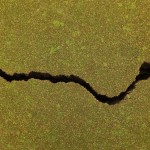4.1 Earthquake Hits East Texas, Reports of Minor Damage
View Texas Earthquakes in a larger map
Update, Jan. 29: On January 29, very early in the morning, another quake struck Timpson, measuring 2.8, according to the USGS.
Original story, Jan. 25: A magnitude 4.1 earthquake struck about two miles Northwest of Timpson,Texas at around 1:00 AM this morning, shaking doors open, knocking pictures off walls, and causing at least one chimney to reportedly collapse in the small East Texas community. You can see where the quake struck in the interactive map above. It occurred three miles below the surface.
“It was like a rumbling, shaking, knocking-you-out-of-the-bed type feeling. It was very, very intense,” Timpson Municipal Court Clerk Paula Mullins told StateImpact Texas by phone. Mullins said she had heard of a neighbor’s chimney falling over, but no reports of injuries.
Quakes have become a semi-regular feature of life in the area lately. The strongest recent quake registered a 4.8 in May.
Researchers say previous quakes in the area have been caused by the use of disposal wells to store waste form oil and gas drilling. Timpson sits in the drilling area of the Haynesville Shale, one of several areas in Texas experiencing a drilling boom.
“At the moment, we are actually linking them [earthquakes] to injection wells that are located close to where the earthquakes are in the Timpson area,” Dr. Wesley Brown, an Associate Professor in the Department of Geology at Stephen F. Austin University told the regional newspaper Light and Champion in December. “We have one a little bit to the north, and [the wells] are north and south of each other,” said Dr. Brown. “The volume, especially for the one in the south, is up over 200,000 barrels of water per month.”
While researchers have known for decades that disposal wells can cause quakes, state regulators say they are waiting for more proof. The Texas Railroad Commission, the agency that regulates oil and gas drilling in Texas, is currently considering updated rules for disposal wells in the state, but it says it has no plans to include consideration of man-made earthquakes in that rule making.
A search on the Texas Railroad Commission’s online database of oil and gas wells shows ten active disposal wells in Shelby County, where the quake took place.
In a presentation to the American Geophysical Union in December, Brown presented a paper (along with Cliff Frohlich of the University of Texas at Austin and Michael Brunt of Eagle Pass Independent School District) on an earlier quake near Timpson. That paper found that the May 17, 2012 Timpson quake and another near San Antonio “are larger than any previous historically reported earthquakes in central and east Texas.”
“Numerous residents of Nacogdoches were awakened by the quake” in Timpson, the report says. “The highest intensities … occurred south of Timpson … where chimneys, fireplaces, and brick veneer siding suffered significant damage.”
And the October 2011 quake near San Antonio? Some people felt serious intensity, with “the shaking displaced and broke numerous small objects and masonry cracked.”
In Timpson, Court Clerk Mullins says she doesn’t remember many quakes in the area until around a year ago, but some quakes were reported there in the 1950s.
“I don’t know if it’s the oil wells or if it’s just the good Lord telling us to get ready,” Mullins said.
The magnitude of 4.0 is generally the point at which earthquakes begin causing light damage. A Level V, or 5.0 magnitude or higher, can damage poorly-constructed buildings. As the US Geological Survey notes, the impacts largely depend on where the earthquake occurs. “An earthquake in a densely populated area which results in many deaths and considerable damage may have the same magnitude as a shock in a remote area that does nothing more than frighten the wildlife,” they write on their webpage.
Another quake shook Irving, Texas in the Dallas-Fort Worth area earlier this week. Quakes have been on the uptick there since the oil and gas boom in Texas began several years ago. Some areas, like Dallas-Fort Worth, had previously had no earthquakes.



